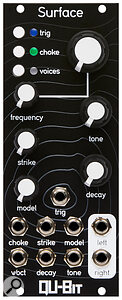Physical modelling can mean anything from the emulation of string or wind instruments to acoustic drums. Qu‑Bit’s Surface collects together several percussive‑style physical modelling algorithms in one 10HP module.
There are seven different digital models to choose from: Pluck, Bell, E Piano 1, E Piano 2, Kick, Snare and Prepared Piano. Each model has three parameters that can be tweaked, Strike, Tone and Decay.
 Qu‑Bit Surface: 10HP, +12V 60mA, ‑12V 60mA.Decay is self‑explanatory, the range being dependant on the selected model. Strike tends to have a sonic effect which might relate to velocity, and Tone will depend on the model. For example, in the Pluck model (a plucked string algorithm) the Tone control adjusts the brightness of the sound, as you would expect. In the Bell model, however, it selects between four different sub‑algorithms, Vibraphone, Steel Drum, Bayan Tabla and Dahina Tabla (not really bells, but no matter).
Qu‑Bit Surface: 10HP, +12V 60mA, ‑12V 60mA.Decay is self‑explanatory, the range being dependant on the selected model. Strike tends to have a sonic effect which might relate to velocity, and Tone will depend on the model. For example, in the Pluck model (a plucked string algorithm) the Tone control adjusts the brightness of the sound, as you would expect. In the Bell model, however, it selects between four different sub‑algorithms, Vibraphone, Steel Drum, Bayan Tabla and Dahina Tabla (not really bells, but no matter).
A trigger input is used to trigger the voice with an LED showing you that everything is working as it should. The LED will be a different colour depending on which model is active. Course and fine tune controls allow you tune the voice through nearly six octaves. A 1V/Oct input allows you to play all models chromatically. Although the unit is capable of playing eight voices, it cannot play multiple notes at once, but it will overlap the tails of successive monophonic notes. If eight voices seems like too much, you can reduce the amount to four, two or one. The choke input will cut all existing voices.
Speaking of voices, the Left and Right outputs may hint at stereo physical modelling, but sadly that is not the case. In normal operation, Left and Right output identical mono signals. Other modes can be enabled which allow specific models to be played to specific outputs, or for either random panning or even/odd voice panning. It’s a shame there is no real stereo information, as this can help greatly with realism in acoustic physical modelling.
A physical modelling module will ultimately succeed, or not, on the strength of its algorithms. In each case, I assessed it by playing keys via the 1V/Oct input, with velocity mapped to Strike. It’s worth noting that if you want proper realistic velocity response, you’ll also need to patch velocity to an external VCA because the Surface itself only makes tonal adjustments via Strike, not amplitude.
Whilst we don’t have the room to analyse each of the models in full, the highlight for me is the Pluck model, which has a slightly plastic nylon guitar sound. I found it a very pleasant and playable sound. Although not altogether realistic, with a bit of reverb it can sound very acoustic and expressive.
Because you can CV control any parameter, including the model selection, Surface can become a very interesting random percussive sound source.
I warmed to some of the other models much less. The Electric Piano models seem like basic FM algorithms, not really physical modelling at all. The Kick and Snare are quite basic and electronic sounding, and the Prepared Piano doesn’t sound like a piano in any way, prepared or otherwise. The Bell algorithms are similarly distanced from their intended goal. If the goal is realism, or even just to sound ‘acoustic’, I would have to say that Surface falls short. In fairness to Qu‑Bit, they do market the Surface as “blurring the line between emulation and synthesis” and, this is modular, where anything goes and brave sound explorers push sonics to their limits. There’s also one special ‘mode’ I haven’t mentioned yet.
Dark Mode is a somewhat hidden option, disabled by default, that is supposed to extend the parameter ranges of each algorithm to allow each sound to stretch beyond sensible limits. For most algorithms, it didn’t seem to make a huge difference. The Pluck model, however, suddenly becomes a blissful, ambient, time‑stretched drone, which I loved. It seemed to me as though this model was much more affected by Dark Mode than the others.
Overall, I think that Surface is capable of some lovely sounds. The Pluck model is the clear winner for me, whilst some other models I could take or leave. Because you can CV control any parameter, including the model selection, Surface can become a very interesting random percussive sound source. I found sequencing the model selection whilst playing melodies produced some fascinating passages that sounded like three or four instruments playing at once. This kind of experimentation is what modular systems are all about. As long as you don’t expect the Surface to give you hyper‑realistic acoustic modelling, it should be an excellent source of interesting and unexpected sounds.
£279
$299
